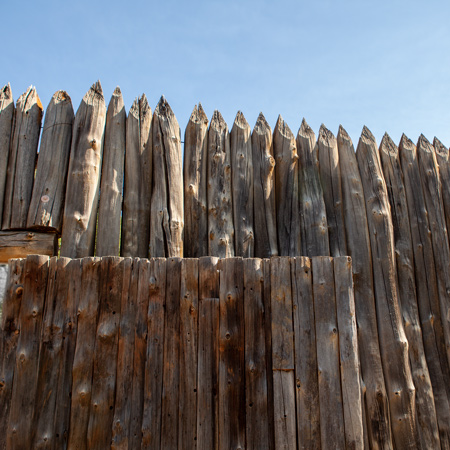At Fort Mandan, Lewis learns that one of the interpreters’ wives has been letting Indians through the gate during the night. Away from the Knife River Villages, Clark’s hunting party kills several deer and elk, and they work hard to process and pack the meat.
Locking the Gate at Night
by Yellowstone Public Radio[1]Originally aired weekdays by Yellowstone Public Radio during the Bicentennial observance of 2003-2006. Narrated by Hal Hansen. Scripts by Whit Hansen and Ed Jacobson. Produced by Leni Holliman. © … Continue reading
Fort Mandan (Reconstruction)
Taken with cooperation from the Fort Mandan Visitors’ Center. Photo © 2013 by Kristopher K. Townsend. Permission to use granted under the Creative Commons Attribution-Share Alike 4.0 International license.
Pleasant and Warm
pleasant & warm. the Savages continue comming to See us and to get blacksmiths work done &.C.—
—John Ordway
Securing the Fort
The Sergt. of the guard reported that the Indian women (wives to our interpreters[)] were in the habit of unbaring the fort gate at any time of night and admitting their Indian visitors, I therefore directed a lock to be put to the gate and ordered that no Indian but those attatched to the garrison should be permitted to remain all night within the fort or admitted during the period which the gate had been previously ordered to be kept shut which was from sunset untill sunrise.—
—Meriwether Lewis
Hunting the River Bottoms
4th Day
hunted the two bottoms near the Camp Killed 9 Elk, 18 Deer, brought to camp all the meat fit to eate & had the bones taken out. every man ingaged either in hunting or Collecting & packing the meat to Camp
—William Clark
Weather Diary
State of the Ther. at rise
Weather Wind at rise
Thermt. at 4 oCk. P.M. Weather Wind at 4 oCk. P.M. River 18 [above 0] fair S E 29 cloudy S raise ½ in. —Meriwether Lewis[2]To assist the reader, the editor of this web page has omitted the date column, merged the “State of the River at
rise” columns, and spelled out some abbreviations.
Experience the Lewis and Clark Trail
The Lewis and Clark Trail Experience—our sister site at lewisandclark.travel—connects the world to people and places on the Lewis and Clark Trail.
Plan a trip related to February 7, 1805:

Fort Mandan is a High Potential Historic Site along the Lewis and Clark National Historic Trail managed by the U.S. National Park Service. The North Dakota Department of Parks and Recreation manages a modern reconstruction and the Lewis and Clark Interpretive Center located at US Hwy 83 and ND Hwy 200A.
Knife River Indian Villages National Historic Site is a High Potential Historic Site along the Lewis and Clark National Historic Trail managed by the U.S. National Park Service. A unit of the National Park System, the site is located at 564 County Road 37, one-half mile north of Stanton, North Dakota. It has exhibits, trails, and a visitor center.
Notes
| ↑1 | Originally aired weekdays by Yellowstone Public Radio during the Bicentennial observance of 2003-2006. Narrated by Hal Hansen. Scripts by Whit Hansen and Ed Jacobson. Produced by Leni Holliman. © 2003 by Yellowstone Public Radio. |
|---|---|
| ↑2 | To assist the reader, the editor of this web page has omitted the date column, merged the “State of the River at  rise” columns, and spelled out some abbreviations. rise” columns, and spelled out some abbreviations. |



